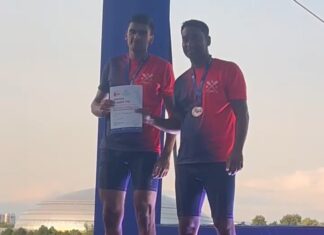The Italian ski resorts located in the beautiful Dolomites area in South Tyrol have long played a crucial role in establishing the month of December as a strong part of the World Cup tour initially mostly based on the January ‘Classics’ in Switzerland, Austria and France.
Organizers from Val Gardena – and later on Alta Badia – were soon aware of how interesting it was for them to host World Cup races at the season start to promote their resorts on the international ski market and attract tourists in their locations at the beginning of the winter.

After having successfully hosted a World Cup downhill in February 1969 and the FIS World Championships the following year, Val Gardena/Gröden quickly bid in October 1970 World Cup committee chairman Serge Lang to become a longtime partner of the circuit – and was quickly awarded more races in March 1972. A few months later, the tradition of hosting the first downhill after the Critérium de la Première Neige at Val d’Isère began on 15 December when Switzerland’s legendary Roland Collombin celebrated his maiden win on the circuit 10 months after grabbing Olympic silver at Sapporo, Japan. Since 2007, a super-G has been added to the racing program.
Val Gardena is often remembered by veterans and ski historians for its thrilling World Cup Finals in March 1975, when three champions – Austria’s Franz Klammer, Italy’s Gustav Thoeni and Sweden’s Ingemar Stenmark – fought for the big crystal globe in the parallel slalom held on an icy slope at St Ullrich/Ortisei situated at the beginning of the beautiful valley leading to Selva di Gardena dominated by the spectacular Sassolungo peak.
All of them had scored 240 points before that final competition, Klammer having won his eighth downhill of the season out of nine the previous day on the Saslong course. The 1976 Olympic champion was soon eliminated on the treacherous and very icy slope, leaving Thoeni and Stenmark fighting till their very last run. An estimated crowd of nearly 20,000 spectators attended that competition and were loudly exulting when the Scandinavian ace skied out in the last part of his final run, only two gates before the finish line.
In the following years, nearly all leading speed specialists achieved great performances on the beautiful Saslong run so famous among the fans for its spectacular Camel Jumps section where racers fly sometimes 80 meters over the snow.
Franz Klammer and Cortina’s Kristian Ghedina have been most successful in downhill with four wins each and several podium finishes – yet Norway’s Aksel Lund Svindal won a total of five races there in the last years including four super-Gs. Interestingly enough, the two-time winner at Val d’Isère two weeks ago, his teammate Kjetil Jansrud, reached the podium five times in the last three years, winning the super-G in 2014. A year ago, the Attacking Vikings achieved an impressive clean sweep in super-G with Svindal finishing ahead of Jansrud and their younger teammate Aleksander Aamodt Kilde.
The tough Gran Risa challenge:
Only a handful of racers travel to Alta Badia a few hours after the downhill to compete in the first of the three most prestigious giant slalom races of the season held on the very demanding Gran Risa slope. To shine in that event included since 1985 in the World Cup calendar surely is the goal of all established giant slalom specialists who also aim to excel on the prestigious Chuenigsbergli run at Adelboden and the Podkoren slope at Kranjska Gora in January and March. In fact, the winners’ list include the names of some of the most famous GS skiers in the last decades starting with Swedish ski legend Ingemar Stenmark in 1985.
Only two athletes achieved the hat-trick in those three major GS races – Italy’s Alberto Tomba in his great 1994/95 season and the USA’s Ted Ligety during the 2012/13 winter when he celebrated a total of six wins and two third-place finishes on the World Cup tour as well as three gold medals at the FIS World Championships at Schladming.
Alta Badia has always been a special place for the charismatic skier from Bologna who enjoyed there its first World Cup podium exactly 30 years ago – finishing second behind his teammate Richard Pramotton. Three months later he was the only member of the Squadra Azzurra able to clinch a medal at the 1987 FIS World Championships at Crans-Montana – before becoming the flamboyant ‘Tomba-la-Bomba’ after his unexpected wins at Sestriere and his Olympic triumphs at Calgary in February 1988. Tomba won the giant slalom four times and reached the podium three more times in second or third place.
In recent years, the numerous fans amassed around the finish line attended amazing battles between the two best GS specialists on the tour – Ligety and Austria’s Marcel Hirscher, unbeaten in the event since 2013 while Ligety won there in December 2010 and 2012. Hirscher also captured a slalom set on the lower part of the steep Gran Risa run back in 2011.
The steep slope has also inspired the best French specialists who often reached the podium there, including the actual leader in the GS standings, Alexis Pinturault, second place there in December 2013. Despite the recent injury to his right hand, the skier from Courchevel will fight hard to become the third Frenchman after Joel Chenal in 1999 and Pascal Covili in 2001 to triumph in that stunning event.
He has two chances to leave the resort as a winner as a parallel giant slalom is again scheduled in the evening on the next day after having been successfully tested last winter. Pinturault finished it in fifth place while Norway’s Kjetil Jansrud and Aksel Lund Svindal captured the first two places ahead of Sweden’s Andre Myhrer.















